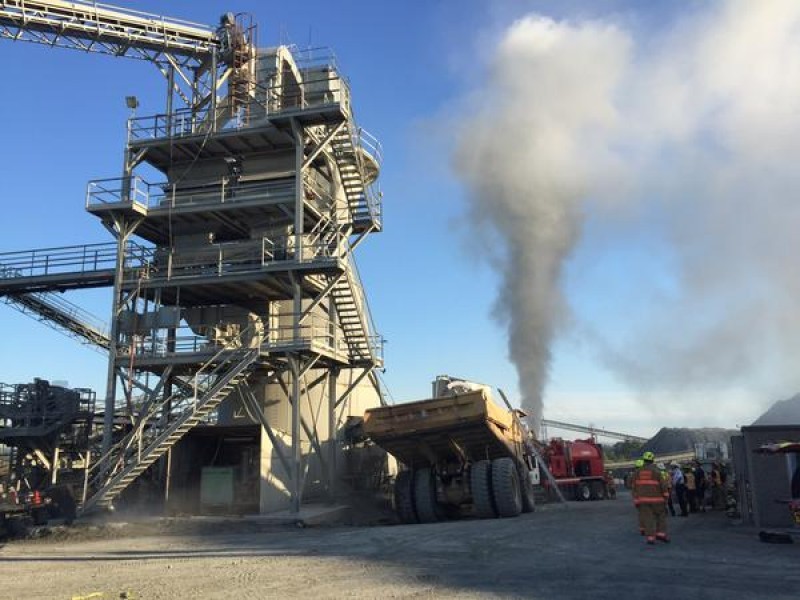A five-most-dangerous job for teens: Construction and height work
According to Bureau of Labor Statistics fatality records, construction and roofing are two of the ten most dangerous jobs in America. In 2014, 20.5 percent of all work fatalities—essentially one in five—were in construction, accounting for 874 deaths. A construction worker is nearly three times as likely to die from a work accident as the average American worker.
The leading causes of death on construction sites are falls, electrocution, getting struck by object, and getting caught in-between (a broad category that include cave-ins, getting pulling into machinery, and getting hit by machinery.) These four causes accounted for nearly six in 10 deaths.

An 18-year-old worker was killed when a silo collapsed at this construction site in 2015.
Young workers are especially at risk given their relative inexperience on work sites and commonplace dangers construction sites often pose. According to NIOSH in 2002, youth 15-17 working in construction had greater than seven times the risk for fatal injury as youth in other industries. In a 2003 release, NIOSH noted that despite only employing 3 percent of youth workers, construction was the third leading cause of death for young workers—responsible for 14 percent of all occupational deaths to youth under 18.
Labor laws limit the work of 16-and 17-year-olds in construction, but we know from news reports that teens are doing hazardous work and getting hurt.
In June 2009, a 9-year-old Alabama boy at a construction site fell through a skylight and was seriously injured. Press reports did not reveal if the boy was actually working, but according to state inspectors his presence at a site at which minors are prohibited from working is considered evidence of employment under the law.
Other examples of recent construction deaths among teens can be found below:
- In August 2015, Daniel Potter, 18, of Front Royal, Virginia died in a Loudoun County quarry as he emptied mineral filler (used in asphalt) from a metal silo into a truck. The corroded silo suddenly burst apart burying the teen under the filler and metal pieces of the container.
- 16-year-old Tristin James Wood of Marquand, Missouri was killed in June 2014 after he was told to stand in a construction zone without a hard hat and was hit on the head by the boom of a crane. OSHA cited the employer for 13 serious safety violations.
- In July 2014, Chris Lawrence died at construction site near Calgary, Canada when he became entangled in a conveyor at a gravel crushing site. The boy was still in training.
- David “Drew” Kimberly was crushed to death on January 16, 2014 when a bridge panel weighing nearly 1,800 pounds fell on him as he was taking apart an old bridge in Lamont, Florida. It was his first week on the job.
- Thomas Harlan Jr., age 15, of Lucedale, Mississippi, was killed when his head was struck by a pole moving on a tram.
- A man removing trees from a construction site accidentally ran over his own son, 16-year-old Damon Spring in Celina, Ohio in August 2013.
- In November 2011, 18-year-old Maynro Perez died working on a construction site in Rock Hill, South Carolina in an accident that involved a backhoe.
- In August 2010 in Edgerton, Ohio, 18-year-old Keith J. LaFountain died of injuries from blunt force trauma when a wall fell over from high winds.
- That same month in Grand Island, Nebraska, 19-year-old Emilio DeLeon was electrocuted after coming in contact with power lines while working as a roofer. DeLeon was in the bucket of a crane when the lines were touched.
- In January 2010, Danilo Riccardi Jr. was trying to get water from a trench so that he could mix concrete when he fell into the large room-sized hole. A muddy mixture of sand and water soon trapped him like quicksand. By the time rescuers arrived, the boy was dead, submerged under the liquid mixture. It took almost three hours to dig his body out.
- A 15-year-old Lawrenceville, Georgia boy, Luis Montoya, performing demolition work in November 2008, fell down an empty escalator shaft 40 feet to his death. According to a spokesman for the Georgia Department of Labor, minors—defined in the state as being 15 years old—are not allowed to work on construction sites. The company that employed the boy, Demon Demo had been fined by OSHA in 2005 and 2008 because workers did not wear required safety harnesses to prevent falls. The fine in the second violation was reduced from a $4,000 penalty to $2,000. Montoya was not wearing a safety harness when he fell.
- Bendelson Ovalle Chavez, a 17-year-old resident of Lynn, Massachusetts, was fixing a church roof in September 2007 when he fell 20 feet to his death. Employed by the company two months earlier, he had received no training or information about how to prevent falls, according to a report by the Massachusetts AFL-CIO and the Massachusetts Coalition for Occupational Safety and Health.
- In July 2007, James Whittemore, 17, died while taking down scaffolding at a construction project in Taunton, Massachusetts. The teen was helping his father remove the scaffolding when a pole he was holding fell against a high-voltage electrical wire and he was electrocuted. The boy died in his father’s arms.
Roofing work is generally prohibited for teens under 18.
Federal child labor law prohibits construction work for anyone less than 16 years of age, although youths 14 and 15 may work in offices for construction firms if they are away from the construction site.
Labor law regarding work at heights has some inconsistencies. Minors 16 years and older may work in heights, as long as it is not on or above a roof. They can work on a ladder, scaffold, in trees, and on structures like towers, silos, and bridges.
Your state may have a higher minimum age.


